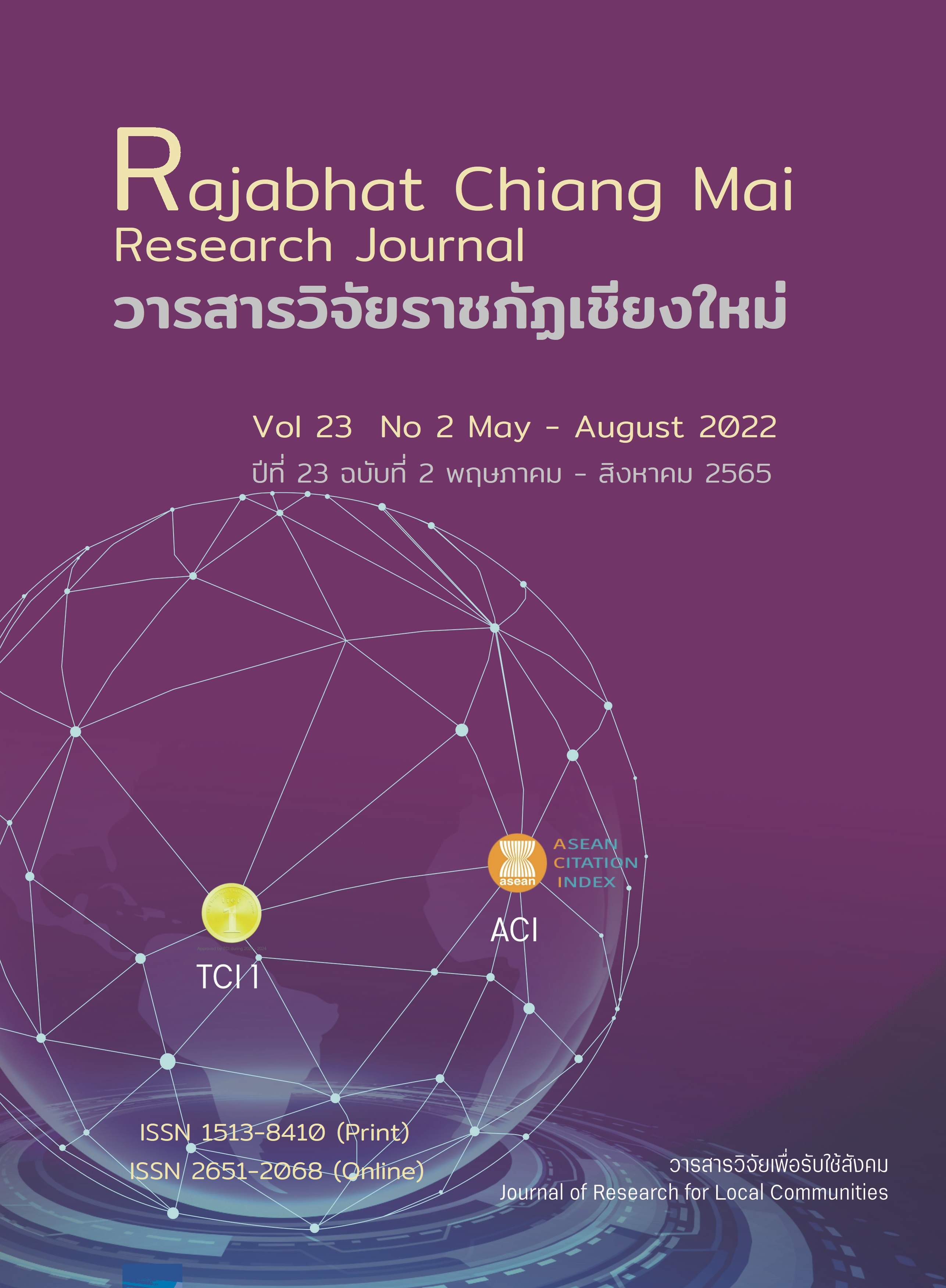Sufficiency Economy Promotion for Community Economic Development of Ban Chai Thale Rangchan Community, Samut Sakhon Province
DOI:
https://doi.org/10.14456/rcmrj.2022.258959Keywords:
Economic development, Community economic, Sufficiency economy, Career and income development, Community enterpriseAbstract
The objectives of the research were to study the level of sufficiency economy promotion and to study that promotion of sufficiency economy as it relates to the economic development of the Ban Chai Thale Rangchan community. A sample of 162 people of Village 4, Ban Chai Thale Rangchan by Krejcie and Morgan Tabel. The data collection tool was a questionnaire. The data was analyzed by using statistics, percentage, arithmetic mean, standard deviation and the Pearson Correlation Coefficient. The results of the study showed that the level of promotion of the sufficiency economy of the Ban Chai Thale Rangchan community, was high ( =3.57). Promotion of the model community of sufficiency economy attained the highest average ( =3.66). The promotion of the sufficiency economy, including the promotion of the Sufficiency Economy Community model, the promotion of Sufficiency Economy Learning Center, the Group of Seafood Processing Community Enterprise Development and the development of community tourism were found to have positive correlation with the development of the community economy through its financial system and capital, all of which contributed to enhancing welfare, career and income development, with a statistical significance at 0.01 level. The results of the study on the promotion of the sufficiency economy in relation to the community economic development of Ban Chai Thale Rangchan demonstrates that to strengthen a model for the sufficiency economy community, the community must continually create a learning process in the community, develop new products, and build distribution channels for community products both within and beyond the community, including the online distribution channel, in order to strengthen the stability of the basic community economic system.
Downloads
References
Bhanthumnavin, D., & Bhanthumnavin, D. (2007). Sufficiency Economy at Individual Level: Theory and Research Findings for The Construction of Psycho-Behavioral Indicators. NIDA Development Journal, 47(1), 27-79. (In Thai) https://so04.tci-thaijo.org/index.php/NDJ/article/view/2697/2069
Boonyasana, P., & Himakalasa, W. (2018). System and Community Economic Network Following the Sufficiency Economy Philosophy. Journal of Humanities and Social Sciences Srinakharinwirot Research and Development, 10(19), 127-139. (In Thai) https://so04.tci-thaijo.org/index.php/swurd/article/view/140809/104341
Chanchaichaovivat, A., Chinkhamphanoa, P., & Kirdtabtim, S. (2014). Kaomark Processing Products for Supporting Community Economy. Journal of Research Unit on Science, Technology and Environment for Learning, 5(2), 186-195. (In Thai) https://ejournals.swu.ac.th/index.php/JSTEL/article/view/4805/4605
Cowen, M. P., & Shenton, R. W. (1996). Doctrines of Development. London and New York : Routledge.
Damrongchai, N. (2018). A Model for Sustainable Development in Thai Communities under the Sufficiency Economy Concept. Sukhothai Thammathirat Open University Journal, 31(1), 92-107. (In Thai) https://so05.tci-thaijo.org/index.php/stouj/article/view/206758/143717
Griffin, R. W. (1999). Management (6th ed.). USA : Houghton Miffin Company.
Jiwju, N., Siboonnun T., Tachayapon, A., Sirikitsathien, C., Nuamai, C., & Buapuen, P. (2015). Reproducing Effective Lesson on Sufficiency Economy for Developing Wangnumdaeng Community, Moo 5, Thamkeua Sub-district, Klongklung District, Kamphaengphet Province. The 2nd KamphaengPhet Rajabhat University National Conference. 210-227. (In Thai) https://research.kpru.ac.th/sac/fileconference/28392018-05-03.pdf
Kaewkhwaunkrai, T. (2019). Community Economy: Community Capital Accumulation for Survival. Hatyai Academic Journal, 17(1), 69-83. (In Thai) https://so01.tci-thaijo.org/index.php/HatyaiAcademicJournal/article/view/128832/137862
Serthpol, N. (2019). Processes of Community Economic Development in Phayao, Thailand. Dhammathas Academic Journal, 19(2), 215-224. (In Thai) https://so06.tci-thaijo.org/index.php/dhammathas/article/view/170767/139568
Sroingern, R., Pinthapataya, S., & Boonyasopon, T. (2020). Model Development of Shopping Center Business Management in Congruence to the Community Economy. The Journal of King Mongkut's University of Technology North Bangkok, 30(4), 698-706. (In Thai) http://ojs.kmutnb.ac.th/index.php/kjournal/article/view/2347/3211
Watcharakiettisak, T. (2016). Community Economic Strengthening by Developing Community Enterprise Group at Tambonpolsongkram Administration, Nongsung district, Nakonratchasima Province. Journal of Business Administration The Association of Private Higher Education Institutions of Thailand, 5(1), 43-54. (In Thai) https://so02.tci-thaijo.org/index.php/apheitvu/article/view/95225/74410
Downloads
Published
How to Cite
Issue
Section
License
Copyright (c) 2022 Rajabhat Chiang Mai Research Journal

This work is licensed under a Creative Commons Attribution-NonCommercial-NoDerivatives 4.0 International License.
1. Articles, information, content, images, etc published in the “Community and Social Development Journal” are copyrighted by the Community and Social Development Journal, Chiang Mai Rajabhat University. In order to properly distribute the articles through print and electronic media, the authors still hold the copyright for the published articles under the Creative Commons Attribution (CC BY) license, which allows the re-distribution of the articles in other sources. References must be made to the articles in the journal. The authors are responsible for requesting permission to reproduce copyrighted content from other sources.
2. The content of the articles appearing in the journal is the direct responsibility of the article authors. The editorial board of the journal does not necessarily agree with or share any responsibility.














